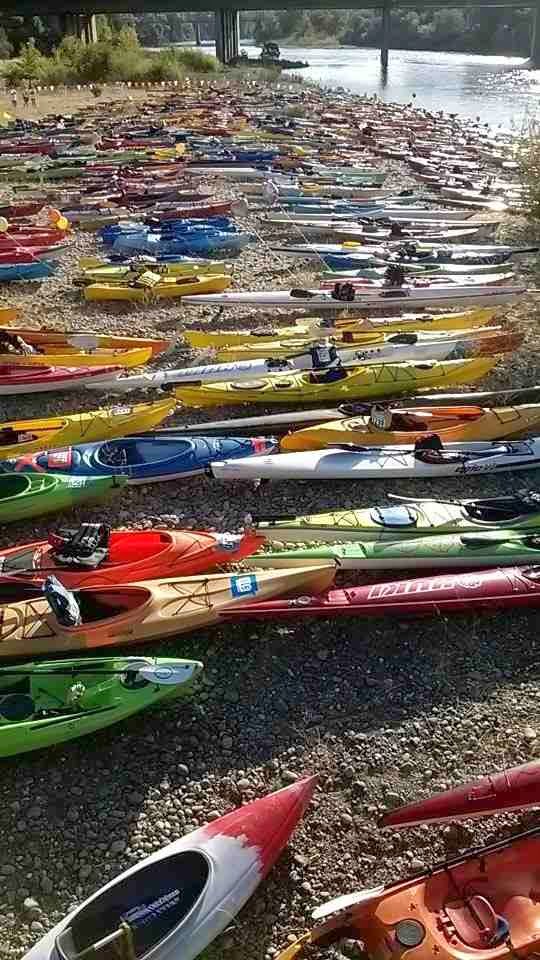Kayaking and canoeing seems to be all about gear or location. There are magazine articles and internet posts about everything from what to wear, to where to go and how to paddle. There's great advice out there, but nothing will guide us back and remind us of that special time on the water more than music. However, I have never seen any tips on how to write good old fashion
paddling songs. So, I asked singer/songwriter
and fellow paddler Jerry Vandiver what it takes to compose an ode to the stream?
The Nashville-based Vandiver has brought his two passions together by creating a collection
of paddling songs such as
More Than A River, and
True and Deep. A concert touring favorite with over 15 million records sold, Vandiver is never far from the lakes and rivers he loves to sing about. Last week, he offered me some inspiration on how to put a song in your next journey.
NC: Which is easier going down a Class V waterfall or writing a paddling song?
JV: It's funny in that I've been studying the craft of songwriting
about as long as I've studied the craft of paddling. And the passion
for both endeavors is pretty darn equal. But considering that I've
gotten myself in a lot of trouble on some hefty rapids, I'd have to go
with writing the song as a bit easier. I will say this, when you finish
the run or finish the song, they both equal themselves in fun and a
feeling of really accomplishing something.
NC: So then is writing a paddling song more like going up stream or going down river?
JV: Oh, definitely going down river. You always have to go with the
flow. I have more often than not found that if you let the song take
you where it wants to go, it will always come out better than if you
fight it with some crazy upstream stroke.
NC: Did "Dueling Banjos" and the phrase "Paddle faster. I think I hear
banjos," add to the difficulty of writing a good paddle song?
JV: Actually, I think it is interesting that we associate music about
paddling as being very acoustic in instrumentation, even sometimes to
the point of straight out Bluegrass style as in "Dueling Banjos".
There's some spirit of kinship between natural acoustic instruments and
the flow and excitement of the water and the great outdoors. I can't
imagine hearing synthesizers and squeaky backwards LPs when singing
about paddling. I'll take Dueling Banjos as inspiration anytime.
NC: How often are you tempted to work "Bootie Beer" into a song?
JV: Until now, I'd never thought of it! But hmmmmmm.
NC: Okay... You got the start to a great paddling song, but you hit a
rock towards the end and it is sinking. It's to late to scrap it. How
do you Duct Tape it back together?
JV: Pull into the nearest shore, set up camp, brew some "Camp Coffee",
watch the sun set and sleep on it. That's part of going with the
flow. It'll come back and finish itself sometimes when you let it.
NC: Some of us have lost loves. An upset kayak leaves without saying
goodbye or a canoe stolen away in the night. Both never return. Any
tips on how to work them into song without making our wives jealous?
JV: Well, if you're lucky the wife will be mourning with you - or at
least send you a sympathy card. But for those that have spouses that
don't "get it", you're only choice is to use the age old phrase, "she
really meant nothing to me". The wife won't believe it, but it might
buy you a little more grieving time before you set out to spend the
family budget on a new boat.
NC: Has a song just hit you while you are out paddling or do you need a special place like the BWCA?
JV: I've had these songs come at me just about everywhere. Even
walking our dogs down the neighborhood alley. The important thing is to
have those experience to tap into - floating a crystal clear Ozark
stream, fighting a headwind in the north woods lakes, rafting a Colorado
Canyon or kayaking through a Class III in Tennessee. Those memories
always stay with you and will find their way up with a melody if you let
them. Regardless of where you may be at the time.
NC: Does anything really rhyme with Boofin?
JV: How about "goofin" as in "goofin' off in a swimming hole"?
Find more information on Jerry Vandiver and his music at www.paddlesongs.com




























